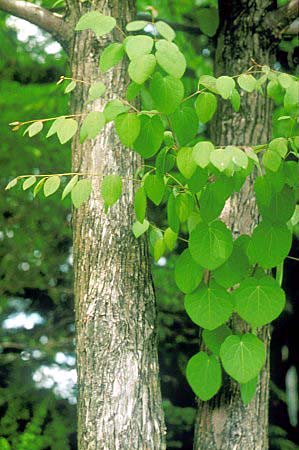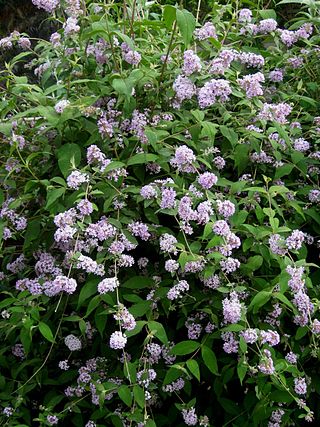
Magnolia virginiana, most commonly known as sweetbay magnolia, or merely sweetbay, is a member of the magnolia family, Magnoliaceae. It was the first magnolia to be scientifically described under modern rules of botanical nomenclature, and is the type species of the genus Magnolia; as Magnolia is also the type genus of all flowering plants (magnoliophytes), this species in a sense typifies all flowering plants.

Magnolia grandiflora, commonly known as the southern magnolia or bull bay, is a tree of the family Magnoliaceae native to the Southeastern United States, from Virginia to central Florida, and west to East Texas. Reaching 27.5 m (90 ft) in height, it is a large, striking evergreen tree, with large, dark-green leaves up to 20 cm long and 12 cm wide, and large, white, fragrant flowers up to 30 cm (12 in) in diameter.

Ficus benjamina, commonly known as weeping fig, benjamin fig or ficus tree, and often sold in stores as just ficus, is a species of flowering plant in the family Moraceae, native to Asia and Australia. It is the official tree of Bangkok. The species is also naturalized in the West Indies and in the states of Florida and Arizona in the United States. It is one of the most common trees in Israeli cities and parks. In its native range, its small fruit are favored by some birds.

Cercidiphyllum is a genus containing two species of plants, both commonly called katsura. They are the sole members of the monotypic family Cercidiphyllaceae. The genus is native to Japan and China and unrelated to Cercis (redbuds).

Magnolia fraseri, commonly known as Fraser magnolia, mountain magnolia, earleaf cucumbertree, or mountain-oread, is a species of magnolia native to the south-eastern United States in the southern Appalachian Mountains and adjacent Atlantic and Gulf Coastal Plain from West Virginia south to northern Florida and west to eastern Texas. The Appalachian plants are classified as Magnolia fraseri var. fraseri, and the more coastal plants as M. fraseri var. pyramidata. These two kinds of magnolia are often recognized as distinct species, M. fraseri and M. pyramidata, respectively.

Magnolia campbellii, or Campbell's magnolia, is a species of Magnolia that grows in sheltered valleys in the Himalaya from eastern Nepal, Sikkim and Assam, India, east to southwestern China and south to northern Myanmar.

Magnolia sieboldii, or Siebold's magnolia, also known as Korean mountain magnolia and Oyama magnolia, is a species of Magnolia native to east Asia in China, Japan, and Korea. It is named after the German doctor Philipp Franz von Siebold (1796–1866).

Magnolia officinalis is a species of Magnolia native to the mountains and valleys of China at altitudes of 300–1500 m.

Salvia hians is a mound-forming perennial, native to the Himalayas from Pakistan to Bhutan. It is common in Kashmir, growing at elevations from 2,400 to 4,000 m on open slopes and forests. The plant was described in 1830 by John Forbes Royle, a British botanist living in India who studied the medicinal properties of Himalayan plants.
Magnolia globosa, the globe magnolia or hen magnolia, is a species of Magnolia native to Bhutan, southwestern China, northeastern India, northern Myanmar-Burma, and eastern Nepal.

Codiaeum variegatum is a species of plant in the genus Codiaeum, which is a member of the family Euphorbiaceae. It was described by Carl Linnaeus in 1753. It is native to Indonesia, Malaysia, Australia, and the western Pacific Ocean islands, growing in open forests and scrub.

Euonymus fortunei, the spindle, Fortune's spindle, winter creeper or wintercreeper, is a species of flowering plant in the family Celastraceae, native to east Asia, including China, Korea, the Philippines and Japan. E. fortunei is highly invasive and damaging in the United States, causing the death of trees and forest in urban areas.

Rosa chinensis, known commonly as the China rose, Chinese rose, or Bengal rose, is a member of the genus Rosa native to Southwest China in Guizhou, Hubei, and Sichuan Provinces. The first publication of Rosa chinensis was in 1768 by Nikolaus Joseph von Jacquin in Observationum Botanicarum, 3, p. 7 & plate 55.

Abies delavayi, the Delavay's silver-fir or Delavay's fir, is a species of fir, native to Yunnan in southwest China and adjoining border areas in southeastern Tibet, far northeastern India, northern Myanmar, and far northwestern Vietnam. It is a high altitude mountain tree, growing at elevations of 3,000–4,000 m, often occupying the tree line.

Paeonia delavayi is a low woody shrub belonging to the peonies, that is endemic to China. The vernacular name in China is 滇牡丹. In English it is called Delavay's tree peony, Delavay peony, Dian peony, and dian mu dan. It mostly has red brown to yellow, nodding flowers from mid May to mid June. The light green, delicate looking deciduous leaves consist of many segments, and are alternately arranged on new growth.

Paeonia ludlowii, is a deciduous shrub of medium height, belonging to the tree peony section Moutan of the genus Paeonia, and endemic to southeast Tibet. In Tibet it is known as ≠'lumaidao' meaning "God's flower". The vernacular name in Chinese is 大花黄牡丹 meaning "big yellow-flowered peony". In English it is sometimes called Tibetan tree peony or Ludlow's tree peony. It has pure yellow, slightly nodding, bowl-shaped flowers, and large, twice compounded, light green leaves.

Buddleja delavayi is a Chinese species discovered by Forrest in the Tali Range above Dali, Yunnan, in 1910; it is also found in Xizang (Tibet). The species was named for l'Abbé Delavay, the French missionary and plant collector, by Gagnepain in 1912. The shrub is of interest to the botanist because of its unique resting buds and the different types of inflorescence produced through the year.

Iris delavayi is a species of flowering plant in the subgenus Limniris and in the series Sibiricae of the family Iridaceae. This rhizomatous herbaceous perennial comes from various provinces in China. It has grey-green leaves, long hollow stem, and 2 flowers in various blue shades. From dark violet, dark purple, purple-blue, dark blue to light purple. It is cultivated as an ornamental plant in temperate regions.

Lonicera similis is a species of flowering plant in the family Caprifoliaceae, native to Western China. This honeysuckle is known in cultivation by the variety delavayi which is reported by some authorities to be synonymous with L. similis itself. It is a large, twining, semi-evergreen shrub growing to 8 m (26 ft) tall by 1.5 m (4.9 ft) broad, with a profusion of fragrant tubular flowers opening white and ageing to yellow, in late summer and autumn. The flowers are followed by black berries. The Latin specific epithet similis means “similar to”. It is similar in appearance to L. japonica, but larger and more robust. The name delavayi honours the French missionary and botanist Père Jean Marie Delavay (1834-1895).

Itoa is a genus of flowering plants in the family Salicaceae. It is also in the tribe Saliceae.





















